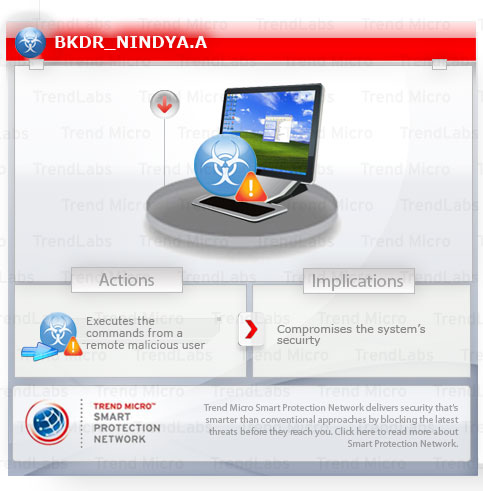BKDR_NINDYA.A
Windows 2000, XP, Server 2003


Threat Type: Backdoor
Destructiveness: No
Encrypted: No
In the wild: Yes
OVERVIEW
Trend Micro has flagged this backdoor application as noteworthy due to the increased potential for damage, propagation, or both, that it possesses. Specifically, it is a file downloaded by a malicious script file, which takes advantage of a 0-day exploit in Firefox.
To get a one-glance comprehensive view of the behavior of this Backdoor, refer to the Threat Diagram shown below.

This backdoor may be downloaded by other malware/grayware from remote sites.
It executes commands from a remote malicious user, effectively compromising the affected system.
TECHNICAL DETAILS
TCP Port 443
48,640 bytes
PE
Yes
26 Oct 2010
Arrival Details
This backdoor may be downloaded by the following malware/grayware from remote sites:
- JS_NINDYA.A
Installation
This backdoor drops the following copies of itself into the affected system:
- %Temp%\symantec.exe
(Note: %Temp% is the Windows Temporary folder, which is usually C:\Windows\Temp or C:\WINNT\Temp.)
Autostart Technique
This backdoor adds the following registry entries to enable its automatic execution at every system startup:
HKEY_CURRENT_USER\Software\Microsoft\
Windows\CurrentVersion\Run
Microsoft Windows Update = %Temp%\symantec.exe
HKEY_LOCAL_MACHINE\SOFTWARE\Microsoft\
Windows\CurrentVersion\Run
Microsoft Windows Update = %Temp%\symantec.exe
Backdoor Routine
This backdoor opens the following port(s) where it listens for remote commands:
- TCP port 443
It executes the following commands from a remote malicious user:
- Date
- ipconfig
- net start
- dir - to be done in all drives/folders
- tasklist /v
- Taskkill /im
- net user
- net view
- del /s /q *.* - to be done in all drives/folders
- shutdown
- ver
- exit
It connects to the following URL(s) to send and receive commands from a remote malicious user:
- l-3com.{BLOCKED}s.tv (l-3com.{BLOCKED}s-work.com)
Other Details
Based on analysis of the codes, it has the following capabilities:
- Sends back the results of the aforementioned commands back to the remote server.
It connects to the following URL(s) to check for an Internet connection:
- nobel.usagov.mooo.com
- www.update.microsoft.com
SOLUTION
8.900
7.572.04
28 Oct 2010
7.573.00
28 Oct 2010
Step 1
For Windows XP and Windows Server 2003 users, before doing any scans, please make sure you disable System Restore to allow full scanning of your computer.
Step 3
Terminate a process file/s detected as BKDR_NINDYA.A
*Note: If the detected file/s is/are not displayed in theWindows Task Manager, continue doing the next steps.
Step 4
Delete this registry value
Important: Editing the Windows Registry incorrectly can lead to irreversible system malfunction. Please do this step only if you know how or you can ask assistance from your system administrator. Else, check this Microsoft article first before modifying your computer's registry.
- In HKEY_CURRENT_USER\Software\Microsoft\Windows\CurrentVersion\Run
- Microsoft Windows Update = %Temp%\symantec.exe
- Microsoft Windows Update = %Temp%\symantec.exe
- In HKEY_LOCAL_MACHINE\SOFTWARE\Microsoft\Windows\CurrentVersion\Run
- Microsoft Windows Update = %Temp%\symantec.exe
- Microsoft Windows Update = %Temp%\symantec.exe
Step 5
Scan your computer with your Trend Micro product to delete files detected as BKDR_NINDYA.A. If the detected files have already been cleaned, deleted, or quarantined by your Trend Micro product, no further step is required. You may opt to simply delete the quarantined files. Please check this Knowledge Base page for more information.
Did this description help? Tell us how we did.

